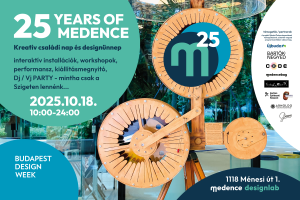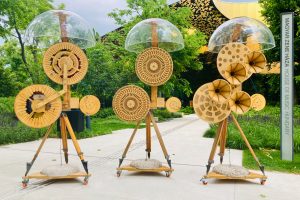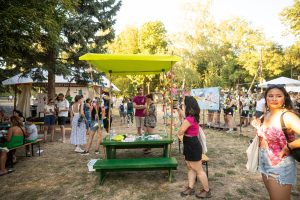After more than two years of preparation, planning and construction, the Creative Sound Space, billed as a palace of musical wonders, opened on 18 May 2022 as a stand-alone attraction on level -2 of the Hungarian House of Music.
In the relatively small space of 130 m2, we created 8 large-scale, unique interactive installations. Each of these sound-inducing visual devices takes a playful, innovative approach to the components and interrelationships of sound, rhythm and music, with eight different installations presenting different slices of the infinitely rich world of sound.
The final shape and operation of the installations were developed based on Dani Váczi's conceptual design, coordinated by a team of more than 30 designers and contractors. This was the most complex and large-scale project we have carried out so far. The creative challenge was unprecedented, with many exciting challenges to overcome, compounded by the epidemic waves of recent years. The process was led by Tóbiás Terebessy and András Gross, with many excellent partners, small and large teams of experts, masters and workshops, while Dani was the conductor, always keeping in mind the integrity and quality of the initial concept. A végeredményben a térben megvalósult nyolc különféle installáció, mint működő prototípus és egyben műalkotás, melyek egy konceptuális egységben jelennek meg, vizuálisan, formailag és anyagfelhasználásában egyaránt koherensen.
Robot Orchestra
The custom-designed, purpose-built electronic devices, circuits and minipcs are all made with great care. In designing the Orchestrion installation, we drew heavily on György Ligeti and his thoughts on modern organ building. In a 1968 article, he explains in detail what improvements and new features he could exploit as a composer. Many of these have not been implemented to date. Essentially, it is a modular instrument with special (e.g. 'talking') stops, which can be used with infinite flexibility by means of a central computer. The head of a multi-generation Belgian organ-building company Tony Decap 's special automatic instruments and wooden organ pipes not only provide Orchestrion with a unique sound, but are also the first step in an organ project that will make Ligeti's dream come true, as the development of the instrument has not stopped after the delivery, and the air supply will be controlled by a digital control system that can be individually tuned for each pipe in the next upgrade.
Chladni-Theremin
At the end of the 18th century, the German physicist Ernst Chladni discovered that if you throw sand on an iron plate and then vibrate it with a bow, you get different interesting patterns depending on the height of the sound. Russian physicist Leon Theremin invented the first gesture-controlled electronic musical instrument in 1919. The Chladni-Theremin installation links these two inventions, which are distant in space and time.
Creative Studios
Even for adults, the Creative Studio is an exciting playground where anyone can learn simple chords, melodies and rhythms on guitar, bass, synthesizer, drums and even try their hand at singing through instructional videos. After practicing, the improvised band can make their first recording together in the studio.
Rhythm-dolly
On the Rhythm Machine, a gigantic rattling acoustic rhythm machine, you can create four-part rhythm compositions, which are visually displayed in a projected animation generated by the XORXOR interactive team.
An electro-mechanical installation with an acoustic sound, similar to a hand propeller, which can be driven by 2-4 people by hand from two sides. The drive turns a flywheel, which is connected to four digital rhythm adjustment dials on the wheel axles. Each unit is a loop, or sound-making circle (both physically and musically). The loops are associated with different rhythm instruments, which are located in the wheels of the crank. The instruments are struck or shaken by electromagnets when they are activated within the loop. Each instrument can be set to sound at a specific point in the loop by turning the knobs on the dial in a circle on and off. The tempo is determined by the speed of the crank. It's basically a digitally controlled acoustic drum machine with freely variable elements that are always in sync with each other.
The installation also includes visualisation. The algorithmic animation is synchronised with the sounds that are currently being heard, displaying a changing, geometrically stylized running landscape. Each instrument is associated with a particular shape, which appears when the instrument is played.
Up to 6 to 8 visitors can play it at the same time, some driving the levers, others adjusting the sounds within the loops, others changing the instruments in the loops, but it is also a great experience for passive listeners and spectators.
Sound-ball-track
A fun game for the little ones is the Bouncing Balls Track, where visitors can build a musical path of balls and the balls they roll will bring to life tinkling melodies.
Wall-mountable modular ball tracks, in which balls rolled by visitors play a melody as they run along wall-mounted rails and hit a soundboard. The desired melody can be produced by arranging the metalophone soundboards in one and a half octaves and the rails of different lengths. The elements adhere to the steel-plate covered wall with tiny magnets. The installation is a coherent surface with three play zones, two parking zones and an operator / info zone, in the following order:
- Fixed track (Mozart: Magic Flute, Magic Bell)
- Free play interface, Free track
- Parking
- Programmed track with LED backlight and its control panel
All these elements form a coherent surface, so you can build a giant ball track across the entire width of the wall.
Clavimera
The Klaviméra is a custom-built keyboard instrument-kiméra based on the concept of Dániel Váczi. Each key of its one and a half octave keyboard has a different sound mode. The aim of the installation is to show the different keyboards in a playful way, arranged in such a way that the actions of each key can be followed. The sequence of instruments and mechanisms does not follow a strict chronological order, it is up to the player to discover the connections. Some of these instruments are still in everyday use today, such as the Viennese and English mechanical pianos, others are rarities and curiosities from the past, such as the roll piano, the clavichord or the celesta. The instrument parts have been pieced together in unusual associations by the luthier Álmos Derzsi Pap. The waveforms of modern electric sound generation, such as sine, square or sawtooth waves, are displayed on a small OLED display in an oscilloscope-like manner. The electronic instruments, display, motor control and programming were made by Péter Márton. The explanatory diagrams on the instrument's plexiglass cover are by graphic artist Tamás Lakos. A playful work, not without irony and philosophicism, in the end a usable work of art, one of the most educational and subtle sounding elements of the Creative Sound Space.
Sound Painter
By singing or playing the piano with the Sound Painter, voices bring colourful shapes to life on a virtual spherical surface, displayed by a holoventillator.
The Sound Painter is a real-time sound visualisation tool that creates an intuitive, interdisciplinary relationship between the world of sounds, images and numbers. Sounds sung by the visitor or played on a MIDI keyboard draw colourful lines on a virtual sphere. The visualisation is done with the help of a holographic fan, which creates the effect of a sphere appearing in the air. The Embroidery Sphere works on the principle of sound-timing: the 12 chromatic musical notes correspond to the 12 directions of the plane, and are also analogous to the 12 colours of the colour wheel. Embroidery machines are characterised by the movement of the fabric under the needle, which moves in one direction; similarly, a virtual sphere rotates under the embroidery ball's stationary writing instrument in response to the sound. When the embroidery machine is silent, the writing instrument leaves no trace, but the ball continues to rotate in the direction it has started. The logic of the sound - rotation direction correspondence is very simple: the 12 chromaticities are analogous to the 12 positions of the clockwise hand, the colour correspondence progresses according to the colour wheel from red to violet. The visitor can activate the sphere by playing a MIDI keyboard or singing into the funnel, and the eight buttons on the control panel allow the visitor to change the drawing and sound parameters. With a choice of 8 pre-programmed demo tunes, you can draw flower, ball or violin key shapes on the ball.
Music Lab - interactive visual music applications
A box kiosk is set up around a column in the room, on which 3 touch screens of the same design and content are placed, each running 4 applications. The sounds generated by the applications are played through locally placed headphones.
Applications:
Beatbox (Samu Bence, Binaura)
Players can place different visual elements in an infinite sound-space. By positioning the elements in space, sound compositions can be created. A slice of the game space is always visible, this can be panned, the camera can zoom in and show the continuously building visual sound composition from a distance.
Contour (Nagy Ágoston, Binaura)
The player creates music using the different keys assigned to the sounds. Each press adds a sound to the system. This creates a network where different sounds are played automatically, one after the other, with different probabilities. The weighted random melodies depend on how the notes are played on the keyboard. In this way, the grid can be reformatted and taught while listening live. The network is represented by a physical system in which the position of the elements is influenced by different forces (Force Directed Layout)
Memo
The player learns about the internal structure of different musical content by cutting the sound content into small slices, decomposing their original temporality, and rearranging the sound slices in space based on their similarity to each other. Thus, spectrally similar sounds are placed close to each other, and dissimilar sounds are placed far apart. The resulting map shows the musical (spectral) structure of the original pieces as a kind of fingerprint. Slices of notes can be played by touch, or sequences can be created using simple playback heads.
Solmificatio (Mizsei Zoltán, Singer Patrik)
The user enters a text, from which the program generates a melody. Each vowel is assigned a musical note, and the rhythm is determined by time-measured versification.
A Kreatív Hangtér csapata:
Kurátor: Horn Márton, Mandli Endre Vazul – Magyar Zene Háza
Projektmenedzsment: Szabados Gyula – Városliget Zrt.
Koncepció: Váczi Dániel
Installáció design és kivitelezés: Gross András, Terebessy Tóbiás – Medence Csoport Kft.
Belsőépítészet: Báger András, Szabó Áron – Bahcs Művek Kft.
Contributors:
Derzsi Pap Álmos Hangszerész,
Tony Decap – B.V. Organ Factory Decap (Be) (orchestrion), Adorján Zalán – Artizine Bt, Jancsó Gergő (chladni-theremin), Hajdu Gáspár, Papp Gábor – Xorxor Interactive Kft., Nagy Ágoston, Samu Bence – Openform Bt., Bolcsó Bálint, Singer Patrik, Mizsei Zoltán – Fti–Iask (Kreatív programozás, szoftverek),
Battha Gáspár, Márton Péter (elektronika), Csikós Péter – Medium Kft. (vetítéstechnika), Tatai Gergely – Grc Computer Kft. (hardver), Váli Miklós – Oberyn Studio (videó) Lakos Tamás (grafika)
Zenei közreműködők: Sárközi Edina (ének) Németh Bendegúz (gitár) Bartók Vince (basszusgitár) Baranyi Bence (dob) Pozsár Máté (szintetizátor)
További közreműködők: Botlik Tibor, Hofecker Andor, Kakuszi Zoltán, Kochán Attila És József, Mizsei Zoltán, Sárkány Bence, Salamon Árpád, Vicsek Viktor, Kelemen Gábor, Xilo-Ton Kkt.
Belsőépítészeti kivitelezés: Kis-Torma Csaba, Báthory Gábor – Königsberg Hungária Kft., Jurida Péter -5let-1let Kft.
Szakági Tervezők: Rajkai Ferenc, Nagy Dániel (épületvillamosság), Farkas János (világítástechnika), Ambrus Roland (tartószerkezetek) Hajdú András (sprinkler), Fürjes Andor (akusztika), Kormányos Anna (akadálymentesség), Takács Lajos (tűzvédelem).
jegyvásárlás: https://zenehaza.hu/helyszin/kreativ-hangter







